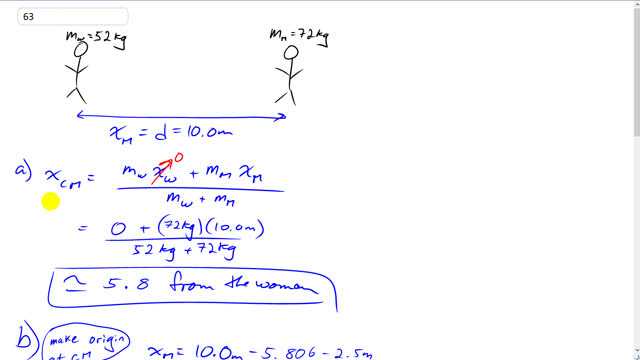
A 52-kg woman and a 72-kg man stand 10.0 m apart on nearly frictionless ice.
- How far from the woman is their CM?
- If each holds one end of a rope, and the man pulls on the rope so that he moves 2.5 m, how far from the woman will he be now?
- How far will the man have moved when he collides with the woman?

In order to watch this solution you need to have a subscription.
This is Giancoli Answers with Mr. Dychko. This woman and man are 10 meters apart and they are standing on some frictionless ice and our job is to figure out where is the centre of mass between these two people? And we'll take the origin to be at the woman to start with for part (a) although in part (b), we'll take the origin to be at the centre of mass. So in part (a) though we have mass of the woman times the distance of the woman to the origin, which is 0, plus the mass of the man times his distance from the woman and divided by the total mass that's gonna give us the x-coordinate of the centre of mass. So that's 72 kilograms—mass of the man— times 10 meters over the total mass 52 kilograms plus 72 means the centre of mass is 5.8 meters from the woman and we expected that to be a bit more than 5, a bit closer to the man than the woman because the man is more massive. And then in part (b), the man pulls on a rope and that, you know, the rope exerts a force on the man and as a Newton's third law counterpart to the force that the man exerts on the rope and also the rope exerts a force on the woman too but we are not gonna solve this using forces but the only thing we need to know about force is the fact that there is no external force at all and so because there's no external force on this man-woman system that means the centre of mass stays where it is even though the man and the woman will be moving. So that makes it a convenient spot to choose to be our origin. And so to find the position of the woman, or of the man I guess, it asks us for the position of the... well, the distance between the man and the woman, that's what we are going for here. Well, we have to figure out the position of the man and of the woman in order to answer that. So here's a formula for, you know, position of the centre of mass which we know is gonna be zero because we are gonna choose the centre of mass to be the origin and we need the mass of the woman times woman's distance to the centre of mass plus the man's mass times his distance to the centre of mass divided by the total mass but you know, when you have divide by something equal zero, you know, you can multiply both sides by that and it's gone and then zero times that is still zero and then you are left with just this on the left hand side. And we can solve this for the distance from the centre of mass to the woman. And so that's gonna be bring this term to the right hand side makes it minus and then divide by the mass of the woman and you get negative 72 kilograms— mass of the man—times 1.694 meters, that's the distance from the man to the centre of mass because he starts at 10 meters away. we learn from part (a) that the distance from the woman to the centre of mass is 5.806 meters and then the question tells us for part (b) the man moves 2.5 meters closer to that centre of mass so this distance shrinks by 2.5 meters and then also take away this distance from the woman to the centre of mass to get the distance between the man and the centre of mass. Okay. And now the separation between the man and the woman is gonna be the distance from the man to the centre of mass minus the distance from the woman to the centre of mass. Notice that the woman's distance is negative and so it's not really so much a distance as it is a displacement; it's good that we have a negative sign that means it's to the left of this origin. And so we have 1.694 meters minus negative 2.345 meters and that gives 4.0 meters is the separation between the man and the woman now. And the collision occurs after the man moves all the way to the centre of mass because while he's pulling on this rope, there's still no external forces involved— there's no friction here we are told— and that means the centre of mass is not moving and the man and the woman will arrive at the centre of mass at the same time and so the collision will occur after the man moves 5.806 meters or sorry, 4.2 meters I should say. Yeah this 5.806 is the separation between the woman and the centre of mass. So either way you look at it; either the woman moves 5.806 meters or the man moves 4.2 meters, in either of those cases, there will be a collision of the two.